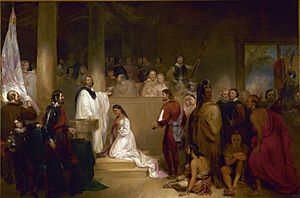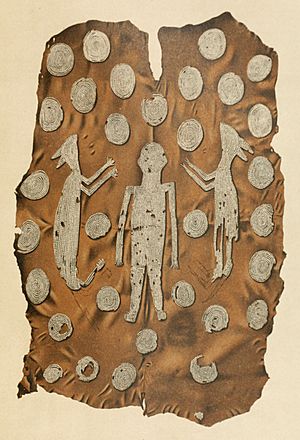Powhatan (Native American leader) facts for kids
Quick facts for kids
Wahunsenacawh, Powhatan
|
|
|---|---|

Powhatan, from a map by English settler John Smith (1612)
|
|
| Born | c. 1547 |
| Died | c. 1618 (aged 70–71) |
| Resting place | Pamunkey Reservation, King William, Virginia, United States |
| Occupation | Leader of the Powhatan people of Tsenacommacah, an alliance of Algonquian-speaking people |
| Children | Pocahontas and others |
| Relatives | Opechancanough (brother) John Rolfe (son-in-law) |
Powhatan (born around 1547 – died around 1618), whose real name was Wahunsenacawh, was a powerful leader. He led the Powhatan people, a group of Native American tribes. These tribes spoke the Algonquian language. They lived in an area called Tsenacommacah in Virginia. This was when English settlers first arrived at Jamestown in 1607.
The English settlers often called him "King" or "Chief" Powhatan. He was the main leader who dealt with the early colonists. He was likely the older brother of Opechancanough. Opechancanough later led attacks against the settlers in 1622 and 1644. Powhatan was also the father of Matoaka, who is famously known as Pocahontas.
Contents
What Was His Name?
When English colonists arrived in 1607, they learned of Wahunsenacawh. They called him Powhatan. This name came from his hometown, which was near the James River. Today, that area is close to Richmond, Virginia.
In the 1600s, English spellings were not set in stone. So, Wahunsenacawh's name was spelled in many different ways. People also used other names or titles for him. These included "Ottaniack" and "Mamauatonick." He was also called "Mamanatowick," which meant "paramount" or "great chief."
Powhatan's Life and Leadership
We don't know much about Powhatan's early life before the English arrived in 1607. He took over leadership of about 4 to 6 tribes. Their main base was near present-day Richmond. By the early 1600s, he had brought together about 30 tribes. He did this through talking and sometimes by force. This group of tribes became known as the Powhatan Confederacy. It's thought that between 10,000 and 15,000 people were part of this confederacy.
In December 1607, English explorer John Smith was captured. He was one of the leaders of the Jamestown colony. Smith was taken by a hunting group led by Opchanacanough, Powhatan's younger brother. Smith was then brought to Werowocomoco. This was Powhatan's main village along the York River.
In 1624, Smith wrote that Pocahontas, one of Powhatan's daughters, saved him from being killed. However, Smith's earlier reports from 1608 and 1612 didn't mention this event. Because of this, many historians wonder if the story is completely true. Some believe that what Smith described was actually a special ceremony. In this ceremony, Smith was welcomed into Powhatan's alliance. He was accepted as a sub-chief of a town called Capahosic. Historian Margaret Williamson Huber said that Powhatan wanted to keep Smith and his men close by. This way, he could keep a better eye on them.
In January 1609, Smith wrote that he told some of his men to build an English-style house for Powhatan. This was at Werowocomoco. In return, the English colony would get food supplies. Both sides were looking for chances to surprise each other. Smith went to Opchanacanough's village. When he was ambushed, he held Powhatan at gunpoint in front of the warriors. When Smith returned to Werowocomoco, the house was not finished. The place was empty. The English workers had left to join the Powhatan side. Today, in Gloucester County, there are ruins believed to be the chimney of this house. It is known as Powhatan's Chimney.
Since 2003, experts believe the real site of Werowocomoco is further west along the York River. It's at a place called Purtan Bay. Archeologists have found signs of a large settlement there. It dates back to 1200. They also found large earthworks built around 1400. Many artifacts have been found, including European items. This shows that the Powhatan people likely traded with English colonists in the early 1600s. In 2006, the Werowocomoco Archeological Site was added to the National Register of Historic Places. A team from the College of William and Mary continues to dig there.
Powhatan later moved his main village to Orapake. This was about 50 miles (80 km) west in a swamp. Today, the meeting point of Interstate 64 and Interstate 295 is near this spot. Between 1611 and 1614, Powhatan moved even further north to Matchut. This is in present-day King William County. It's on the north bank of the Pamunkey River. His younger brother Opchanacanough ruled nearby at Youghtanund.
When Smith left Virginia in 1609, the peace between the colonists and the Algonquian people was already breaking. Soon, fighting led to the First Anglo-Powhatan War. English settlers began to expand beyond Jamestown into Powhatan's land. The colonists destroyed two smaller tribes, the Kecoughtan and the Paspahegh, early in this war. Powhatan sent Nemattanew to fight the English colonists on the upper James River.
In 1613, Captain Samuel Argall captured Pocahontas. After this, Powhatan asked for peace. Peace came when Pocahontas married John Rolfe on April 5, 1614. Rolfe was a leading tobacco farmer. Before their marriage, John Rolfe taught Pocahontas about the new English culture and Christianity. Many stories say that Pocahontas and John Rolfe truly fell in love. Their relationship was by choice. This might help explain why Pocahontas seemed willing to adapt to the new culture, become Christian, and stay with the colonists. She wanted to be with Rolfe. Reverend Richard Buck, a friend of Rolfe's, led the wedding. Before the wedding, Reverend Alexander Whitaker had converted Pocahontas to Christianity and renamed her "Rebecca."
Meanwhile, English colonists kept expanding along the James River. Powhatan was getting older. His last years were described as "ineffectual." Opchanacanough became the stronger Native leader in the area. When Wahunsunacock died in 1618, his next younger brother, Opitchapam, officially became the main chief. However, Opchanacanough, the youngest brother, had gained the most power. He effectively became the new leader of the Powhatan people. He started the Indian Massacre of 1622 and other attacks in 1644. He tried to force the colonists out of Virginia. But these attempts led to strong reactions from the colonists. This eventually led to the near destruction of the Powhatan tribes.
Through his daughter Pocahontas and her marriage to John Rolfe, Wahunsunacock was the grandfather of Thomas Rolfe. In 1635, Thomas Rolfe returned to Virginia from England. Even though he was raised as an Englishman, he respected his Native American heritage. He even visited his uncle, Opchanacanough, and his aunt, "Cleopatra." His true loyalty remained with the colonists. He became a commander of James Fort after the next war. Like his mother, Pocahontas, Thomas Rolfe was not famous during his lifetime. Many of the Rolfe family members became part of the First Families of Virginia. This family had both English and Virginia Indian roots. Some modern tribes, like the Mattaponi and Patawomeck, believe Powhatan's family line also continues through Ka-Okee. She was Pocahontas's daughter by her first husband, Kocoum.
There is a legend that Powhatan, returning from a battle near what is now Philadelphia, stopped at the Big Spring on Sligo Creek. This is in present-day Takoma Park, Maryland, near Washington, DC. He supposedly rested there to heal his wounds in the special waters. Most modern historians don't believe this story. Still, a statue of Powhatan has stood at the site since 1985.
What Did Powhatan Look Like?
In 1608, John Smith described Powhatan. He said Powhatan lay "proudly upon a bedstead a foot high upon ten or twelve mats." He wore "many chains of great pearls about his neck." He was covered with a large blanket of "Rahaughcums" (raccoon skins). A woman sat at his head, another at his feet. On each side of the fire, his main men sat on mats. There were ten in a row. Behind them were many young women. Each wore a large chain of white beads over their shoulders. Their heads were painted red. Smith said Powhatan had a "grave a majestical countenance." This made Smith admire "such state in a savage."
"Powhatan's Mantle" is the name of a special cloak. It is made of deerskin. It is decorated with shell patterns and figures. This cloak is kept at the Ashmolean Museum in Oxford. People say it belonged to Powhatan, but we are not sure. The Mantle is one of the oldest Native American items to be found in a European collection. It must have belonged to a Native American leader. It was decorated with many valuable native shell beads.
In 1906, Norman Wood wrote about Powhatan in his book Lives of Famous Chiefs. He based his description on reports from English colonists. Powhatan was said to be a "tall, well-proportioned man with a sower looke." His head was "somewhat gray." His beard was "so thinne that it seemeth none at all." He was "neare sixtie" years old. He had a "very able and hardy body, to endure any labor."
Places Connected to Powhatan
- Powhatan's burial mound is on the Pamunkey Indian Reservation in King William. His brother, Opchanacanough, moved his remains there.
- Powhatan County is named after Powhatan and his tribe. It is a bit west of their original land.
- In the city of Richmond, Powhatan Hill is believed to be near Powhatan's main village. A local chief named Parahunt (or Tanx meaning "little" Powhatan) ruled there. When English colonists first met him, they thought he was the Great Powhatan. This confusion still appears in old historical stories.
- Powhatan's central village, Werowocomoco, is thought to be in Gloucester County, Virginia. The Werowocomoco Archeological Site is listed on the National Register of Historic Places. Digs there have taught us a lot about the early Powhatan people and their interactions with English colonists.
Tribes in Powhatan's Confederacy
Powhatan became chief and gained control of six tribes. He inherited them from his father, whose name is not known.
Those six tribes included:
- Arrohattoc (Arro-hattoc/Arrohateck)
- Appomattoc (Appomattox)
- Mattaponi (Mattapa-nient)
- Pamunkey
- Youghtanund
- Powhatan
Through his leadership, Powhatan brought together more tribes. These formed The Powhatan Confederacy (Tsenacommacah):
- Accohannock
- Accomac
- Chesapeake
- Chickahominy
- Kiskiack (Chiskiack)
- Cuttatawomen
- Kecoughtan
- Moraughtacund (Morattico)
- Nandtaughta-cund
- Nansemond
- Opiscopank (Piscataway)
- Paspahegh
- Piankatank
- Pissaseck
- Patawomeck (Potomac)
- Quiyoughcohannock
- Rappahannock (Tappahannock)
- Sekakawon (Secacawoni)
- Warraskoyack (Warrascocake/Warwick-squeak)
- Weanoc (Weyanock)
- Werowocomoco
- Wiccocomico (Wiccomico)
See also
 In Spanish: Jefe Powhatan para niños
In Spanish: Jefe Powhatan para niños



